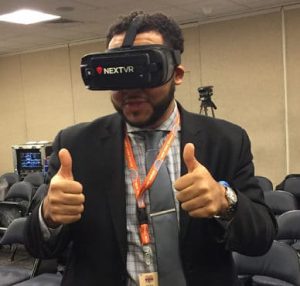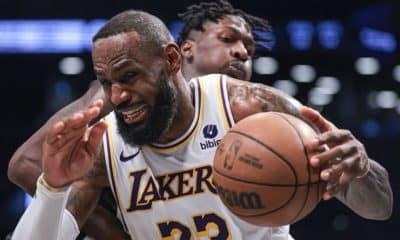NBA
The NBA’s Virtual Reality Revolution
The NBA is now broadcasting in virtual reality, but this year’s foray into the technology is just the start.
Virtual reality is not new. In the early 1800s, painters began experimenting with panoramic murals depicting some historic event or battle scene, and they were so huge and expansive as to encompass viewers’ entire fields of vision.
There was research supporting the brain’s ability to process three-dimensional images as far back as the 1830s, and in 1849 David Brewster would invent the lenticular stereoscope, which essentially was the precursor to the 3D View-Master and later the futuristic-looking VR rigs used for mounting smartphones.
It may have taken us over 200 years to get here, but over the course of the last 24 months, virtual reality has found its way into the hands of consumers in a way that extends way beyond those early stereoscope photos and View-Master slides. Today, thanks to the kind of technology made available by virtual reality companies like NextVR, viewers can strap on a headset and see moving pictures in all their 180-degree or 360-degree glory. The revolution has started, and the National Basketball Association is in on it.
Starting this season, the NBA and NextVR are teaming up to air one game per week in VR. These games occur on Tuesdays, and NextVR brings in their own equipment and production team to make the broadcast work. Even the halftime show is produced in virtual reality, giving fans the most completely immersive viewing experience they can have outside of a real NBA arena.

Anybody who actually has seen a game in virtual reality will admit wholeheartedly that the experience draws them in. With cameras set courtside and underneath the rim, viewers are given a much different perspective of the game than they would watching a traditional broadcast. It is a 180-degree experience rather than a full 360-degree experience, but that’s more than enough for a viewer to turn their head side to side and get a sense of the arena and of course all of the action taking place on the court.
The experience is, frankly, still in its infancy, and there are distinct limitations set on the types of consumers who currently are able to view these broadcasts. For starters, only those with NBA League Pass can access the games, and among those who do subscribe to the league’s premier broadcasting package, only those who own VR rigs and Samsung devices running the Android operating system have the software necessary to view the weekly game projected in virtual reality.
It could easily cost somewhere between $700-800 just to get a foot in the door, but for those who already own the Android devices and have a League Pass subscription, the Samsung VR rig is available for only $99. In fact, there are cardboard rigs available for only $10-15 for those who want to test drive the experience before diving into a major investment, and the NextVR app, which makes viewing these games possible, is free. In other words, the investment for those already invested is minimal.

“We’re really supportive of the efforts that all of the VR hardware platform companies, all of their efforts in that regard, to push their technologies further and to continue to innovate and drive better experiences,” Cramer said. “We’re working with all of the existing and potential VR hardware companies to optimize what they’re doing and to be available as quickly as possible on announced platforms… You’ve seen most of the largest consumer tech companies announcing their involvement and spending billions of dollars in this space and I think it makes sense to believe that you’ll see the same faces ultimately with meaningful positions in the market.”
In other words, it’s only a matter of time before iOS users are afforded the same opportunities for watching these games, and the sooner the better. This experience is too cool to die out the way 3D did a few years ago.
Thankfully, NextVR is offering some things that 3D broadcasts never did.
“When you add what we’ve put into the experience for the fans, the commentary we provide and the ability to do replays and to provide a personalized experience, it’s about more than just transporting someone to the event,” Cramer said. “It’s about giving the information and the context that they need, taking really the best parts that we can from the traditional broadcast experience and making those available to people in an entirely new medium.”
There will be a fair number of VR rigs under Christmas trees this month, which could expand viewership numbers (something that has not been released thus far). To do so would be fruitless considering the small number of people that own Android phones, VR rigs and NBA League Pass. Still, the NBA always seems happy to innovate, which explains why they are the first major professional sports league to show games in virtual reality. NextVR hopes to help them continue that spirit of modernization moving forward.
“We’re innovating every single day, at every point in our workflow and value chain,” Cramer said. “We’re having to create things, from the cameras and the configurations for our cameras and rigs all the way through to our app and our platform that we distribute for playback. It’s constant innovation.”
While there has not been any announcement yet as to whether or not portions of NBA All-Star Weekend will be broadcast in VR, Cramer did admit that NextVR is putting together a plan to try and get involved. A dunk contest in virtual reality, for example, would be revolutionary.
Engineers have come a long way from the lenticular stereoscope, but after two centuries of dabbling in immersive virtual reality, it’s starting to look as if we are finally realizing the technology’s true potential. The really amazing thing is that it’s only going to grow more enveloping and more ubiquitous in the months and years to come.
We may never watch sports the same way again.
Add Basketball Insiders to your Google News Feed!
-
Main Page 1 week ago
LeBron James joins Michael Jordan as only NBA players with multiple 40-point games after turning 39
-
Main Page 1 week ago
Nikola Jokic 1st NBA player since Oscar Robertson with 26+ points, 18+ rebounds, & 16+ assists in a game
-
NBA 1 week ago
Ex-MLB star Alex Rodriguez vows to keep trying to buy Timberwolves franchise despite rejection
-
Main Page 1 week ago
Kings are 14-5 this season when Keegan Murray scores 19+ points











